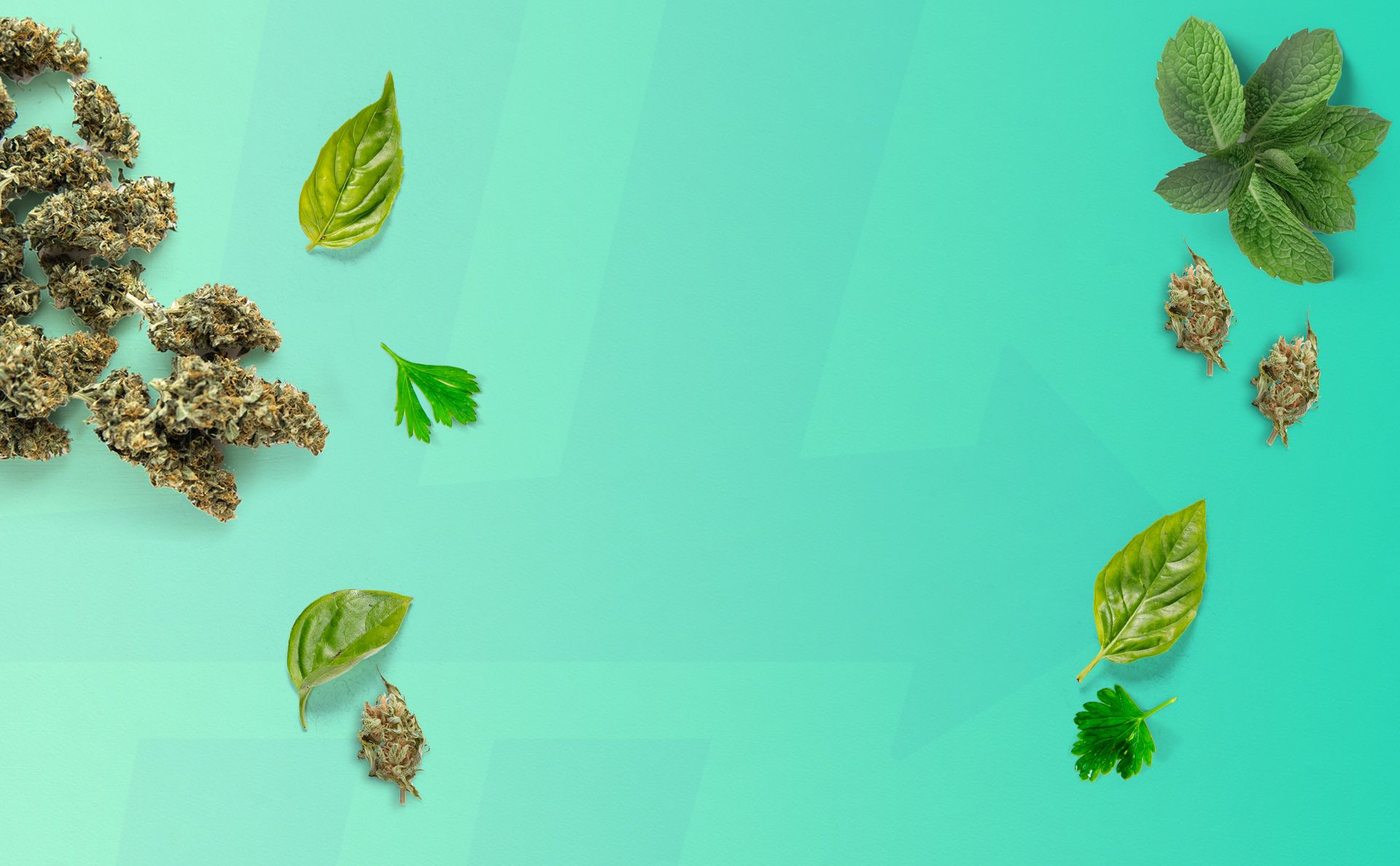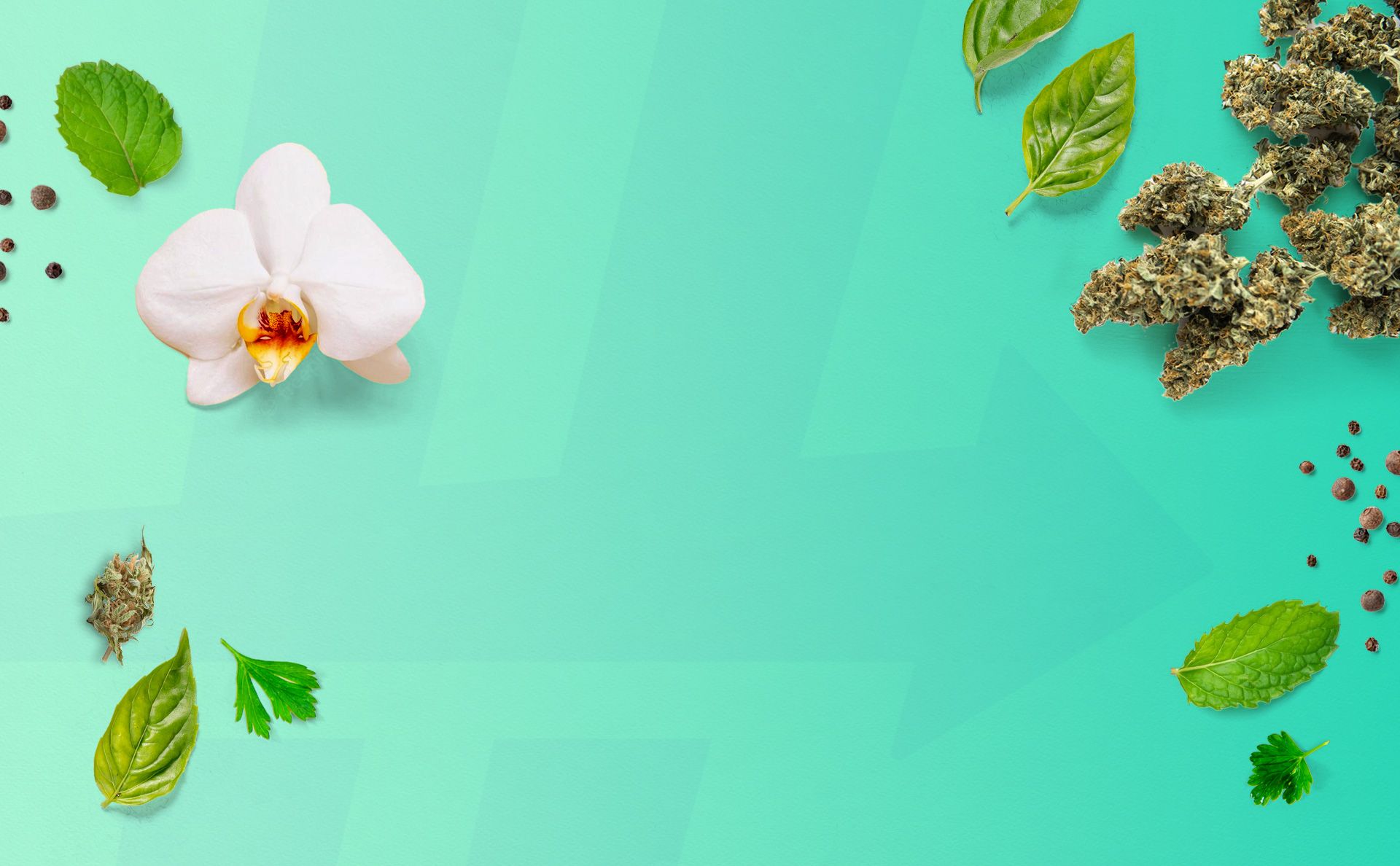Ocimene
In our ocimene chapter, we discuss this group of secondary terpenes that are found in mint, parsley, basil – and cannabis. We also cover ocimene smell and taste, as well as any possible benefits this terpene may have when found in nature.

In this chapter, we break down the ocimene terpene group. What are ocimenes, what do they smell and taste like, and do they have any benefits? Read on for these answers and more.
What is Ocimene?
A common misconception is that ocimene (pronounced “oh-sih-meen”) is a single terpene. In reality, ocimenes are a group of terpenes with the same chemical makeup, just arranged in slightly different positions. The specific types of ocimene commonly found in cannabis are:
- cis-β-ocimene
- trans-β-ocimene
- allo-ocimene
For simplicity, this group is colloquially referred to by the singular base term “ocimene”, which causes the confusion. Ocimenes are actually among the top eight most common terpenes found in North American cannabis, particularly in CBD-dominant varieties.
Still, ocimenes are actually more abundant in other plants, such as:
- Mint
- Parsley
- Allspice
- Tarragon
- Basil
- Orchids
- Pepper
- Mangoes
Terpene Flavor and Aroma Profile: Ocimene
Ocimene has an herbaceous, woody flavor and aroma, with notes of sweetness and hints of citrus. Thanks to its delightful smell, ocimene is a monoterpene additive found in perfumes, colognes, and other cosmetics.

Research shows that ocimene contributes to plants’ natural defense mechanisms, helping them fend off pests as a sap component. Plants containing ocimene secrete oils in sap that act as a deterrent to harmful crop pests like aphids. This is similar to flowers secreting citrus oil to ward off mosquitoes.

What the expert says...
Dr. Abraham Benavides
"Ocimene is found in relatively high abundance in cannabis, but is more abundant in other plants. Ocimene has limited research behind it, but it may be a CB1 agonist and enhance the high you get from THC."
Cultivars with the Terpene Ocimene
Ocimene content tends to vary more than other terpenes, but these cultivars tend to have an above-average amount of it:
- Dutch Treat
- Durban Poison
- Amnesia
- Dream Queen
- Golden Pineapple
- Jack Herer
- OG Kush
- Clementine
- Sour Diesel
- Strawberry Cough
- Chocolope
While it’s rarely a cultivar’s primary terpene, it can often show up as a second or third. CBD-dominant varieties also tend to have higher ocimene profiles.
Does Ocimene Get You High?
Until recently, we used to think that all terpenes were non-psychoactive. However, there is some emerging research basis that shows many common cannabis terpenes can activate CB1 by themselves – including ocimene. CB1 is normally activated by THC, causing a euphoric high and cognitive effects.
This groundbreaking research also suggests this effect is dose dependent, and terpenes like ocimene can increase or potentiate the effects of THC at the CB1 receptor. This kind of synergy gives further credence to the “entourage effect”. A phrase essentially meaning the effects of the whole plant is greater than the sum of its parts.
Since no one’s ingested pure ocimene in a research study (not recommended), we've never been able to figure this out before. Note, it's not safe to take pure, synthetic, or concentrated terpenes by themselves because they constitute natural cleaners, detergents, and can cause serious issues if ingested in higher-than-natural quantities.
Potential Benefits of Ocimene
There is a lack of studies conducted specifically on ocimene in cannabis. This is because it can be difficult to isolate individual terpenes, and dangerous to give concentrated terpenes. There are a few studies done on ocimene derived from other plants, though.
In preliminary studies, ocimene is significantly included but not the main terpene, making it hard to parse specific effects. Ocimene possibly contributes effects like:
- Anti-inflammatory
- Antioxidant
- Antibacterial
- Antifungal
- Anticonvulsant
- Anxiolytic
- Antihypertensive
- Antidiabetic
- Antitumor in test tube and mice models
What We Learned: Ocimene
Ocimene is misunderstood, understudied, often overlooked. However, its woody, sweet, citrusy flavor and aroma are delightful; consuming cultivars that contain this terpene is a great experience. Here’s what we learned about ocimene in this chapter:
- Ocimene is more prevalent elsewhere in the natural world and perfumes than in cannabis.
- Plants rich in ocimene include mint, parsley, allspice, tarragon, basil, orchids, pepper, mangoes, and more.
- Research shows ocimene acts as part of a plant’s natural defense mechanism, helping them fend off pests.
- Cultivars like Dutch Treat, Amnesia, Dream Queen, Golden Pineapple, Jack Herer, and Clementine contain terpenes like ocimene.
- Ocimene may synergize with THC at CB1 to increase the high.
- Limited, preclinical-only studies indicate ocimene may have promising anticonvulsant, anti-inflammatory, antitumor, and antifungal properties.
As we continue to see cannabis research progress forward, we could see the known benefits of terpenes like ocimene increase.
Ready to continue your quest for cannabis knowledge? Answer the question below and continue your journey of learning.
Citations
- Benavides, A. (2022, May 20). Ocimene—Terpenes and Cannabinoid Research. Cannakeys.https://cannakeys.com/ocimene-terpene-research/
- Cascone, P., Iodice, L., Maffei, M. E., Bossi, S., Arimura, G.-I., & Guerrieri, E. (2015). Tobacco overexpressing β-ocimene induces direct and indirect responses against aphids in receiver tomato plants. Journal of Plant Physiology, 173, 28–32.https://doi.org/10.1016/j.jplph.2014.08.011
- Gallily, R., Yekhtin, Z., & Hanuš, L. O. (2018). The Anti-Inflammatory Properties of Terpenoids from Cannabis. Cannabis and Cannabinoid Research, 3(1), 282–290.https://doi.org/10.1089/can.2018.0014
- Liktor-Busa, E., Keresztes, A., LaVigne, J., Streicher, J. M., & Largent-Milnes, T. M. (2021). Analgesic Potential of Terpenes Derived from Cannabis sativa. Pharmacological Reviews, 73(4), 1269–1297.https://doi.org/10.1124/pharmrev.120.000046
- Oboh, G., Ademosun, A. O., Odubanjo, O. V., & Akinbola, I. A. (2013). Antioxidative Properties and Inhibition of Key Enzymes Relevant to Type-2 Diabetes and Hypertension by Essential Oils from Black Pepper. Advances in Pharmacological Sciences, 2013.https://doi.org/10.1155/2013/926047
- Okoli, C. O., Ezike, A. C., Agwagah, O. C., & Akah, P. A. (2010). Anticonvulsant and anxiolytic evaluation of leaf extracts of Ocimum gratissimum, a culinary herb. Pharmacognosy Research, 2(1), 36–40.https://doi.org/10.4103/0974-8490.60580
- Rajendran, M. P., Pallaiyan, B. B., & Selvaraj, N. (2014). Chemical composition, antibacterial and antioxidant profile of essential oil from Murraya koenigii (L.) leaves. Avicenna Journal of Phytomedicine, 4(3), 200–214.https://www.ncbi.nlm.nih.gov/pmc/articles/PMC4104627/
- Raz, N., Eyal, A. M., Zeitouni, D. B., Hen-Shoval, D., Davidson, E. M., Danieli, A., Tauber, M., & Ben-Chaim, Y. (2023). Selected cannabis terpenes synergize with THC to produce increased CB1 receptor activation. Biochemical Pharmacology, 212, 115548.https://doi.org/10.1016/j.bcp.2023.115548
- Bomfim, L. M., Menezes, L. R. A., Rodrigues, A. C. B. C., Dias, R. B., Gurgel Rocha, C. A., Soares, M. B. P., Neto, A. F. S., Nascimento, M. P., Campos, A. F., Silva, L. C. R. C. e., Costa, E. V., & Bezerra, D. P. (2016). Antitumour Activity of the Microehttps://doi.org/10.1111/bcpt.12488
- Sharma, M., Grewal, K., Jandrotia, R., Batish, D. R., Singh, H. P., & Kohli, R. K. (2022). Essential oils as anticancer agents: Potential role in malignancies, drug delivery mechanisms, and immune system enhancement. Biomedicine & Pharmacotherapy, 146, 11https://doi.org/10.1016/j.biopha.2021.112514
- Ugbogu, O. C., Emmanuel, O., Agi, G. O., Ibe, C., Ekweogu, C. N., Ude, V. C., Uche, M. E., Nnanna, R. O., & Ugbogu, E. A. (2021). A review on the traditional uses, phytochemistry, and pharmacological activities of clove basil (Ocimum gratissimum L.). Helihttps://doi.org/10.1016/j.heliyon.2021.e08404
- Valente, J., Zuzarte, M., Gonçalves, M. J., Lopes, M. C., Cavaleiro, C., Salgueiro, L., & Cruz, M. T. (2013). Antifungal, antioxidant and anti-inflammatory activities of Oenanthe crocata L. essential oil. Food and Chemical Toxicology: An International Jouhttps://doi.org/10.1016/j.fct.2013.08.083
Test your knowledge, track your progress and earn your badge.
Which of the following plants is known to contain ocimene?

Dr. Abraham Benavides
Dr. Abraham Benavides is an internationally-recognized cannabis research expert, experienced medical advisor, and full-tuition merit scholar of the George Washington University School of Medicine and Health Sciences. Dr. Abe enjoys helping patients as a writer, educator, and cannabis health coach at the GW Center for Integrative Medicine.